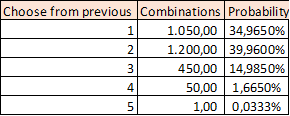I believe this is a conditional or a priori probability problem.
There are 15 balls of different colors in a basket.
In each choice/attempt, WITH REPLACEMENT, 05 balls are chosen randomly.
1- What is the probability of choosing 03 balls from the previous attempt in the second attempt? I mean, repeat 03 colors that were chosen in the previous attempt (First choice/Draw/attempt)?
2- Considering the next attempt, what is the probability of choosing again 3 colors from the previous attempt (Second choice/Draw/attempt)?
I would like the result to be presented with the steps preferably with the construction of functions to reach the result.
Thank you very much in advance guys.
There are 15 balls of different colors in a basket.
In each choice/attempt, WITH REPLACEMENT, 05 balls are chosen randomly.
1- What is the probability of choosing 03 balls from the previous attempt in the second attempt? I mean, repeat 03 colors that were chosen in the previous attempt (First choice/Draw/attempt)?
2- Considering the next attempt, what is the probability of choosing again 3 colors from the previous attempt (Second choice/Draw/attempt)?
I would like the result to be presented with the steps preferably with the construction of functions to reach the result.
Thank you very much in advance guys.

